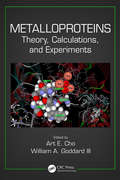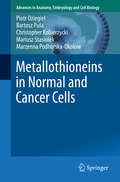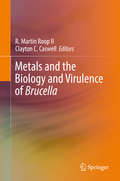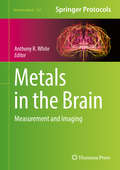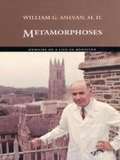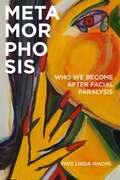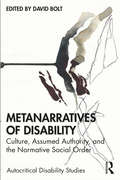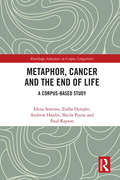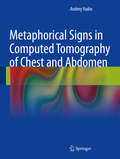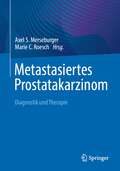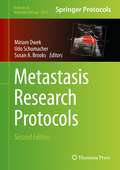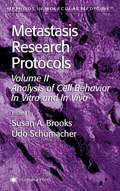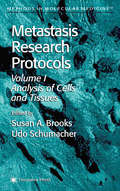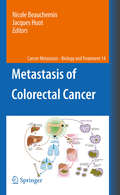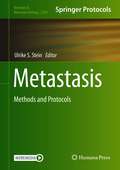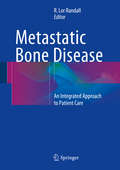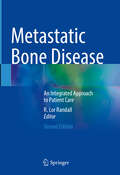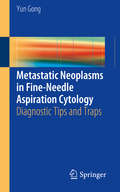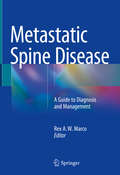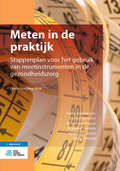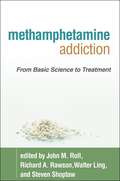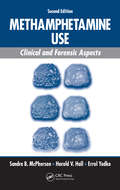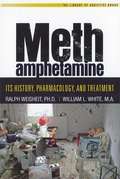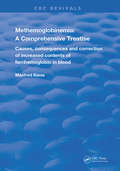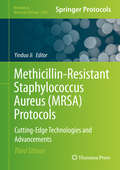- Table View
- List View
Metalloproteins: Theory, Calculations, and Experiments
by Art E. Cho William A. Goddard IIINumerous essential biological functions involve metalloproteins; therefore, understanding metalloproteins and how to manipulate them is significant in the biological and medical fields. An examination of current research, Metalloproteins: Theory, Calculations, and Experiments explores the interplay between theory and experiment, detailing the role
Metallothioneins in Normal and Cancer Cells
by Piotr Dziegiel Bartosz Pula Christopher Kobierzycki Mariusz Stasiolek Marzenna Podhorska-OkolowThis book describes the structures of Metallothionein (MT) family members and the cellular functions of MT-1, MT-2 and MT-4 isoforms, as well as provides insights into divergent biological roles of MT-3. The authors explain the involvement of MT molecules in various processes related to carcinogenesis, including an organ-specific presentation of current data concerning their potential impact on the progression of various tumors and the regulatory role of MT family members in the function of the immune system.
Metals and the Biology and Virulence of Brucella
by R. Martin Roop II Clayton C. CaswellThis book summarises the current knowledge on the role played by biologically relevant transition metals (Fe, Mn, Zn, Ni, Co, Cu and Mg) in the basic biology and virulence of bacterial pathogens from the genus Brucella. The authors explore the biological functions of these metals, how these bacteria compete with their mammalian hosts for these metals and how they avoid metal toxicity. Researchers and professionals studying zoonotic pathogens from the genus Brucella find this book valuable.
Metals in the Brain
by Anthony R. WhiteThis volume explores methods used to examine metal levels and distribution in brain tissue or brain-derived cells. The chapters in this book discuss the use of fluorescent metal probes, synchrotron-based X-ray microscopy, ICP-MS, laser ablation-ICP-MS, laser-based tissue microdissection, MRI image analysis, fractionation of cell tissue samples for metal analysis, and metal treatment of cells. In Neuromethods series style, chapters include the kind of detail and key advice from the specialists needed to get successful results in your own laboratory. Practical and cutting-edge, Metals in the Brain: Measurement and Imaging is a valuable resource for researchers in the rapidly growing area of neuroscience research.
Metamorphoses: Memoirs of a Life in Medicine
by William G. AnlyanWilliam G. Anlyan, a dedicated doctor and gifted administrator, was a leader in the transformation of Duke University Hospital from a regional medical center into one of America's foremost biomedical research and educational institutions. Anlyan's fifty-five-year career at Duke University spanned a period of extraordinary change in the practice of medicine. He chronicles those transformations--and his role in them--in this forthright memoir.Born in Alexandria, Egypt, in 1925, and schooled in the British tradition, Anlyan attended Yale University as an undergraduate and medical student before coming to the relatively unknown medical school at Duke University in 1949 for an internship in general and thoracic surgery. He stayed on, first as a resident, then as a staff surgeon. By 1961, he was a full professor of surgery. In 1964, Anlyan was named dean of the medical school, the first in a series of administrative posts at the medical school and hospital. Anlyan's role in the transformation of the Duke University Medical Center into an internationally renowned health system is manifest: he restructured the medical school and hospital and supervised the addition of almost four million square feet of new or renovated space. He hired outstanding administrators and directed a staff that instituted innovative programs and groundbreaking research centers, such as the Cancer Center and the Physician's Assistant Program.Anlyan describes a series of metamorphoses in his own life, in the world of medicine, in Durham, and at Duke. At the time of his prep school upbringing in Egypt, medicine was a matter of controlling infectious diseases like tuberculosis and polio. As he became an immigrant medical student and then a young surgeon, he observed vast advances in medical practice and changes in the financing of medical care. During his tenure at Duke, Durham was transformed from a sleepy mill and tobacco town into the "City of Medicine," a place where patients routinely travel for open-heart surgery and cutting-edge treatments for cancer and other diseases.Anyone interested in health care, medical education, and the history of Duke University will find Anlyan's memoir of interest.
Metamorphosis: Who We Become after Facial Paralysis
by Faye Linda WachsLosing her smile to synkinesis after unresolved Bell’s palsy changed how Faye Linda Wachs was seen by others and her internal experience of self. In Metamorphosis, interviewing over one hundred people with acquired facial difference challenged her presumptions about identity, disability, and lived experience. Participants described microaggressions, internalizations, and minimalizations and their impact on identity. Heartbreakingly, synkinesis disrupts the ability to have shared moments. When one experiences spontaneous emotion, wrong nerves trigger misfeel and misperception by others. One is misread by others and receives confusing internal information. Communication of and to the self is irrevocably damaged. Wachs describes the experience as a social disability. People found a host of creative ways to reinvigorate their sense of self and self-expression. Like so many she interviewed, Wachs experiences a process of change and growth as she is challenged to think more deeply about ableism, identity, and who she wants to be.
Metanarratives of Disability: Culture, Assumed Authority, and the Normative Social Order (Autocritical Disability Studies)
by David BoltThis book explores multiple metanarratives of disability to introduce and investigate the critical concept of assumed authority and the normative social order from which it derives. The book comprises 15 chapters developed across three parts and, informed by disability studies, is authored by those with research interests in the condition on which they focus as well as direct or intimate experiential knowledge. When out and about, many disabled people know only too well what it is to be erroneously told the error of our/their ways by non-disabled passers-by, assumed authority often cloaked in helpfulness. Showing that assumed authority is underpinned by a displacement of personal narratives in favour of overarching metanarratives of disability that find currency in a diverse multiplicity of cultural representations – ranging from literature to film, television, advertising, social media, comics, art, and music – this work discusses how this relates to a range of disabilities and chronic conditions, including blindness, autism, Down syndrome, diabetes, cancer, and HIV and AIDS. Metanarratives of Disability will be of interest to all scholars and students of disability studies, medical sociology, medical humanities, education studies, cultural studies, and health.
Metaphor, Cancer and the End of Life: A Corpus-Based Study (Routledge Advances in Corpus Linguistics)
by Elena Semino Andrew Hardie Paul Rayson Zsófia Demjén Sheila PayneThis book presents the methodology, findings and implications of a large-scale corpus-based study of the metaphors used to talk about cancer and the end of life (including care at the end of life) in the UK. It focuses on metaphor as a central linguistic and cognitive tool that is frequently used to talk and think about sensitive and subjective experiences, such as illness, emotions, death, and dying, and that can both help and hinder communication and well-being, depending on how it is used. The book centers on a combination of qualitative analyses and innovative corpus linguistic methods. This methodological assemblage was applied to the systematic study of the metaphors used in a 1.5-million-word corpus. The corpus consists of interviews with, and online forum posts written by, members of three stakeholder groups, namely: patients diagnosed with advanced cancer; unpaid carers looking after a relative with a diagnosis of advanced cancer; and healthcare professionals. The book presents a range of qualitative and quantitative findings that have implications for: metaphor theory and analysis; corpus linguistic and computational approaches to metaphor; and training and practice in cancer care and hospice, palliative and end-of-life care.
Metaphorical Signs in Computed Tomography of Chest and Abdomen
by Andrey YudinWhen analyzing the results of diagnostic imaging studies, the radiologist traditionally makes reference to particular features representative of normality or pathology. Most of these features are associated with images of the world around us. This pictorial issue contains nearly 400 illustrations and descriptions of more than 100 classic radiological signs of chest and abdominal diseases that are not named after authors but based on metaphors derived from contemplation of our environment. By correlating the results of computed tomography with these vivid descriptive images, readers will be able to memorize typical and often pathognomonic patterns of disease more quickly and more easily. This book will be of value for both radiology residents and more experienced radiologists.
Metastasiertes Prostatakarzinom: Diagnostik und Therapie
by Axel S. Merseburger Marie C. RoeschDas Prostatakarzinom ist die häufigste Krebserkrankung des Mannes; allein in Deutschland gibt es etwa 70.000 Neuerkrankungen pro Jahr. Bei der krebsspezifischen Mortalität steht das Prostatakarzinom an dritter Stelle. Ein Viertel aller neu diagnostizierten PCA befinden sich bereits in fortgeschrittenem Stadium. Hierzu zählen neben den lokal fortgeschrittenen (cT3/4) auch die primär metastasierten (cN1 bzw. cM1) Tumorstadien. In der Vergangenheit bedeutete eine Metastasierung bei einem bekannten Prostatakarzinom eine nicht kurative Situation. Diese Sichtweise hat sich in den letzten Jahren geändert, da sowohl eine lokale Therapie, wie radikale Prostatektomie oder Bestrahlung in kurativer Dosierung des primären Prostatakarzinoms, ein verbessertes Outcome mit verbessertem Überleben der Patienten bedeutet. Das metastasierte Prostatakarzinom ist auch für erfahrene Behandler anspruchsvoll. In diesem Buch werden die aktuellen Standards zu Risikostratifizierung und Staging sowie den sich derzeit bietenden Therapieoptionen zusammengefasst.Das aktuelle Fachbuch zum Thema für alle Urologen, Onkologen, Strahlentherapeuten, Nuklearmediziner und Internisten.
Metastasis Research Protocols, 2nd Edition
by Udo Schumacher Susan A. Brooks Miriam DwekDiverse molecular, cellular, and environmental events must all come together to allow the successful formation of secondary cancers, metastases. The second edition of Metastasis Research Protocols, brings together the most up to date versions of the seminal techniques that were presented in the first edition and also includes new techniques that have recently been shown to be important in illuminating the processes underlying this important area of biology. Presented by top scientists, the collection includes a wide spectrum of articles encompassing important key methods and to introduce new methods which are making an impact in the area of metastasis research. Volume 1 includes key cellular and molecular techniques relevant to the exploration of cancer cells and tissues, the focus is on the tools that have been shown to be helpful in unravelling the molecular processes important in cancer metastasis. Written in the highly successful Methods in Molecular BiologyTM series format, chapters include introductions to their respective topics, lists of the necessary materials and reagents, step-by-step, readily reproducible laboratory protocols, and key tips on troubleshooting and avoiding known pitfalls. Authoritative and practical, Metastasis Research Protocols, Second Edition seeks to aid scientists in the further study of new methods in the area of metastasis research.
Metastasis Research Protocols, Volume II: Analysis of Cell Behavior In Vitro and In Vivo (Methods in Molecular Medicine #58)
by Udo Schumacher Susan A. BrooksAlthough ninety percent of fatal cancer cases involve the spread of a primary tumor, the formation of metastases is still a poorly understood, complex process and a significant problem in the treatment of cancer patients. In Metastasis Research Protocols, leading international investigators describe in detail the key methods needed to investigate why and how metastasis occurs. Volume II of this two-volume set, Analysis of Cell Behavior In Vitro and In Vivo, presents a comprehensive collection of established and leading-edge techniques for examining metastatic behavior in vitro and in whole animal models. Methods are provided for the separation of cell lines with high and low metastatic potential, along with assay systems to test defined aspects of the metastatic cascade. These systems include cell migration assays, assays for matrix degradation enzymes, basement membrane degradation assays, adhesion assays, and assays of angiogenesis. The detailed descriptions of animal models for metastasis cover the use of immunodeficient animals, syngenic and transgenic models, and orthotopic models of metastasis. The first volume of this set, Analysis of Cells and Tissues, focuses on the analysis and mapping of molecules produced by cells and tissues, and on the molecular biology underlying their expression.
Metastasis Research Protocols: Analysis of Cells and Tissues
by Udo Schumacher Susan A. BrooksMetastasis Research Protocols describes in detail all the methods needed to investigate why and how metastasis occurs. Volume I presents a comprehensive collection of established and leading-edge techniques for analyzing the expression of key molecules and for examining their production at the genetic level. The work focuses on the analysis and mapping of molecules produced by cells and tissues, and on the molecular biology underlying their expression. The traditional methods range from the histopathological and the immunocytochemical to SDS-PAGE, Western blotting, and enzyme zymography. Newer and more specialized techniques for analyzing the genetic aspects of metastasis include in situ hybridization to localize mRNAs, FISH, CGH, methylation analysis of CpG islands, RT-PCR, and differential display. Volume II presents a comprehensive collection of established and leading-edge techniques for examining metastatic behavior in vitro and whole animal models. Methods are provided for the separation of cell lines with high and low metastatic potential, along with assay systems to test defined aspects of the metastatic cascade. These systems include cell migration assays, assays for matrix degrading enzymes, basement membrane degrading assays, adhesion assays, and assays of angiogenesis. The detailed descriptions of animal models of metastasis cover the use of immunodeficient animals, syngenic and transgenic models, and orthotopic models of metastasis.
Metastasis of Colorectal Cancer
by Jacques Huot Nicole BeaucheminColorectal cancer is the third most common cancer worldwide, and in many parts of the western world, it is the second leading cause of cancer-related deaths. This book covers colon cancer metastasis from the most fundamental aspects to clinical practice. Major topics include physiopathology, genetic and epigenetic controls, cancer initiating cells, epithelial-mesenchymal transition, growth factors and signalling, cell adhesion, natures of liver metastasis, angiogenesis and lymphangiogenesis, inflammatory response, prognostic markers, sentinel node and staging, and finally diagnosis and treatment. Each chapter has been contributed by leaders in the field. A key feature is that it connects with a large readership including students, fundamentalists and clinicians. Another specific feature of the book is that the chapters are written in a didactic and illustrative fashion. These characteristics coupled with the choice of the topics and authors, makes this book a reference in the field. It represents an essential acquisition for medical libraries, clinicians as well as medical and graduate students.
Metastasis: Methods and Protocols (Methods in Molecular Biology #2294)
by Ulrike S. SteinThis volume provides the most recent developments and methodologies on metastatic process, formation, and detection. Chapters guide readers through functional metastasis in vitro assays, non-mouse and mice metastasis models, methods for imaging metastasis, analyzing the tumor microenvironment, senescence and inflammation with respect to metastasis, methods to investgate the premetastatic/ metastatic, detecting biomarkers in patient, and bioinformatics to simulate the metastatic process. Written in the highly successful Methods in Molecular Biology series format, chapters include introductions to their respective topics, lists of the necessary materials and reagents, step-by-step, readily reproducible laboratory protocols, and tips on troubleshooting and avoiding known pitfalls. Authoritative and cutting-edge, Metastasis: Methods and Protocols aims to be a useful practical guide to researches to help further their study in this field.
Metastatic Bone Disease
by R. Lor RandallProviding an integrated approach to the diagnosis and management of patients with metastatic bone disease (MBD), this comprehensive text combines discussion of the pathobiology of the disease with the latest oncological and orthopedic treatment modalities. After opening with an examination of the epidemiology and impact of MBD, the biology of bone metastases are discussed, along with considerations of the tissue of origin. Evaluation, biopsy and medical therapy, including metabolic agents and bio targeting. The heart of the book presents oncological approaches (supportive, radiation and interventional) and principles of orthopedic surgical oncology, with subsequent chapters covering specific anatomy, from the pelvis to the lower extremity and the spine. Chapters on emerging surgical technology and future directions conclude the text and redefine an integrated approach to patient care. Taken together, Metastatic Bone Disease is an excellent resource for orthopedic surgeons and cancer specialists alike.
Metastatic Bone Disease: An Integrated Approach to Patient Care
by R. Lor RandallSkeletally related events make up approximately 20% of the cancer care economy. Advances in understanding the pathobiology and better biotargeted therapy and improved surgical technology are occurring continuously. Hundreds of thousands of patients are living longer with ever-increasing tumor burden, but patients can remain siloed in their care as they navigate across subspecialty treatments. This comprehensive text ties it all together around the patient, integrating all aspects of care.Providing an integrated approach to the diagnosis and management of patients with metastatic bone disease (MBD), this revised and expanded text combines discussion of the pathobiology of the disease with the latest oncological and orthopedic treatment modalities. After opening with an examination of the epidemiology and impact of MBD, the biology of bone metastases are discussed, along with considerations of the tissue of origin, evaluation, biopsy andmedical therapy, including metabolic agents and biotargeting. The heart of the book presents oncological approaches (supportive, radiation and interventional) and principles of orthopedic surgical oncology, with subsequent chapters covering specific anatomy, from the pelvis to the lower extremity and the spine. Chapters on emerging surgical technology and future directions conclude the text. New to this edition are considerations around patient-reported outcomes. Utilizing the latest clinical evidence and treatment techniques, Metastatic Bone Disease, Second Edition is standalone resource reflecting a comprehensive, patient-centric resource for all types of providers.
Metastatic Neoplasms in Fine-Needle Aspiration Cytology
by Yun GongThis book focuses primarily on the most efficient way to make an accurate FNA diagnosis of metastatic tumors within the broad confines of cytopathology. The text provides a step-by-step "thought process" during the diagnostic approach of the metastatic tumors using detailed algorithms. Starting from the onsite immediate FNA sample assessment, the book provides strategy of specimen triage to facilitate further cytology evaluation based on the metastatic patterns and morphologic patterns of the tumors. In the subsequent chapter, the book provides tips and traps of selecting markers and interpretation of immunoperoxidase, flow cytometric, cytogenetic and molecular studies. The book includes the strategy of dealing with limited FNA material and wisely use existing samples (cell block, direct smear, cytospin) for different ancillary studies including molecular tests that have been used at MD Anderson. The author highlights challenging issues to show the importance of using a multidisciplinary (clinical, radiologic, cytologic and ancillary studies) approach. Extensive illustrations are provided. Metastatic Neoplasms in Fine-Needle Aspiration Cytology will provide pathology residents, fellows, practicing cytopathologists and cytotechnologists with a practical way to approach metastatic malignancies in daily cytology practice as well as provide a vision of the future of cytopathology.
Metastatic Spine Disease: A Guide To Diagnosis And Management
by Rex A. W. MarcoThis comprehensive text focuses exclusively on the management of metastatic spinal disease, evaluating the most recent literature and providing patient-centered treatment algorithms. Beginning with initial imaging, classification and clinical decision-making, the spine is approached anatomically from the upper cervical to the sacrum, describing the unique considerations and approaches appropriate to each region, such as laminectomy and stabilization, en bloc spondylectomy and resection and reconstruction. Less invasive and minimally invasive approaches are discussed throughout the text. Radiation therapy modalities and other adjuvant treatments are also discussed, as well as reconstructive flap coverage and the management of complications. The spinal column is the most common site of metastatic cancer, and a multidisciplinary approach is required to provide patients with reasonable management options to prevent and treat the disabling symptoms caused by this debilitating condition. This compendium of experience from thought leaders in the treatment of metastatic spine disease will provide spine surgeons, oncologists, radiation oncologists, physiatrists and palliative care specialists with up-to-date information to guide their patients through the multidisciplinary management of metastatic spinal disease.
Meten in de praktijk: Stappenplan voor het gebruik van meetinstrumenten in de gezondheidszorg
by Hester Vermeulen Harriët Wittink Sandra Beurskens Raymond Swinkels Roland Van PeppenHet doel van dit boek is om je aan de hand van een stappenplan te leren op een systematische en kritische manier het juiste meetinstrument te zoeken, te selecteren en de uitkomsten te interpreteren en integreren in het behandelproces. Het uitgangspunt is dat meten geen doel op zich is maar dat het meten processen ondersteunt. Als dat niet het geval is, is het gebruik van meetinstrumenten tijdsverspilling voor zorgprofessionals én patiënten en moet je het niet doen. In de dagelijkse zorg hebben zorgprofessionals veel vragen. Wat wil een patiënt bereiken? Waar gaan we aan werken? Wat zijn de effecten van de zorg? Moet de behandeling worden bijgesteld? Door meten worden deze zaken verhelderd en geobjectiveerd. De zorgprofessional en patiënt hebben hier profijt van, zowel bij het bepalen van de diagnose, het voorspellen van het beloop van het herstel, het samen bepalen van het doel en het evalueren van een behandeling. Meten in de praktijk - Stappenplan voor het gebruik van meetinstrumenten in de gezondheidszorg is onmisbaar voor zorgprofessionals, studenten en docenten aan gezondheidszorgopleidingen in het hoger onderwijs. Daarnaast is het een handige gids voor professionals en kwaliteitsmedewerkers die werkzaam zijn in de gezondheidszorg. In deze derde druk zijn twee hoofdstukken toegevoegd waarbij het accent ligt op het interpreteren en gebruiken van de resultaten in het zorgproces. Verder wordt samengewerkt met de website www.meetinstrumentenzorg.nl waardoor de meetinstrumenten en de gebruikersinformatie vrij toegankelijk beschikbaar zijn. Aansluitend op de patiëntgerichte benadering, ligt het accent in het boek op de zogenaamde 'patiënt reported outcomes' (PRO's). Meten in de praktijk is een prachtig hulpmiddel bij zinvol inzetten van meetinstrumenten waarbij de zorgprofessional en de patiënt gezamenlijk het doel en verloop van de behandeling bespreken en bepalen en deze na afloop evalueren. De focus in dit boek ligt meer op ‘Weten waarom en wat je wilt meten’ dan op het bekende ‘Meten is weten’.
Methamphetamine Addiction
by John Roll Richard RawsonSeparating myth from fact, this authoritative work reviews the breadth of current knowledge about methamphetamine addiction and describes the most promising available treatment approaches. Leading experts present state-of-the-art information on the effects of methamphetamine on the brain, body, mental health, and behavior. Psychosocial and pharmacological treatment strategies are critically evaluated, including approaches to treating dually diagnosed clients. Written in a concise, accessible style, the volume emphasizes that recovery is possible, despite the significant challenges the drug poses. The authors identify key avenues for collaboration among clinical, public health, and other professionals.
Methamphetamine Use: Clinical and Forensic Aspects, Second Edition
by Sandra B. McPherson Harold V. Hall Errol YudkoUpdated and expanded to reflect changes in recent years, this second edition covers virtually every aspect of this dangerous drug, including history, pharmacology, pathology, physiology, treatment, clinical and forensic psychology, and legal aspects. This edition features new chapters on criminal- and civil-forensic applications including an in-depth discussion of recent laws. Pointing out important cases, articles, and statistics, the text also presents chapters on neuropsychological testing; normative data on risk analysis and violence prediction; the physiology of tweaking, the most dangerous stage of the meth cycle; and the efficacy of treatment programs including examples from newly established drug courts.
Methamphetamine: Its History, Pharmacology and Treatment
by Whilliam L. White Ralph WeisheitThe definitive book on the impact of methamphetamine on individuals, communities, and society by two of America's leading addiction and criminal justice experts.In recent years, the media have inundated us with coverage of the horrors that befall methamphetamine users, and the fires, explosions, and toxic waste created by meth labs that threaten the well-being of innocent people. In Methamphetamine: Its History, Pharmacology, and Treatment, the first book in Hazelden's Library of Addictive Drugs series, Ralph Weisheit and William L. White examine the nature and extent of meth use in the United States, from meth's early reputation as a "wonder drug" to the current perception that it is a "scourge" of society.In separating fact from fiction, Weisheit and White provide context for understanding the meth problem by tracing its history and the varying patterns of use over time, then offer an in-depth look at:the latest scientific findings on the drug's effects on individualsthe myths and realities of the drug's impact on the mindthe national and international implications of methamphetamine productionthe drug's impact on rural communities, including a case study of two counties in the Midwestissues in addiction and treatment of meth.Thoroughly researched and highly readable, Methamphetamine offers a comprehensive understanding of medical, social, and political issues concerning this highly impactful drug.Written for professionals and serious lay readers by nationally recognized experts, the books in the Library of Addictive Drugs series feature in-depth, comprehensive, and up-to-date information on the most commonly abused mood-altering substances.
Methemoglobinemia: A Comprehensive Treatise (Routledge Revivals)
by Manfred KieseFirst Published in 1974, this book offers a full, comprehensive guide into Methemoglobinemia. Carefully compiled and filled with a vast repertoire of notes, pictures, and references this book serves as a useful reference for Students of Medicine, and other practitioners in their respective fields.
Methicillin-Resistant Staphylococcus Aureus: Cutting-Edge Technologies and Advancements (Methods in Molecular Biology #2069)
by Yinduo JiThis third edition volume expands on the previous editions with an update on the latest techniques used for the detection, genotyping, and investigating pathogenesis of Staphylococcus aureus in vitro and in vivo. The methods covered in this book mostly focus on routine clinical diagnosis, surveillance, research, and practice for treatment of patients infected by multi-drug resistant S. aureus. The book also covers the epidemiology of MRSA, molecular typing approaches, clinical treatment of MRSA infections, and animal models of drug discovery. Written in the highly successful Methods in Molecular Biology series format, chapters include introductions to their respective topics, lists of the necessary materials and reagents, step-by-step, readily reproducible laboratory protocols, and tips on troubleshooting and avoiding known pitfalls.Informative and cutting-edge, Methicillin-Resistant Staphylococcus Aureus (MRSA) Protocols: Cutting-Edge Technologies and Advancements, Third Edition is a valuable resource for researchers looking to set up new methods to study S. aureus, and will also be very useful for technicians and scientists working on other bacterial pathogens.
